University Health and Social Care: Principles and Practices Report
VerifiedAdded on 2019/12/03
|10
|3519
|143
Report
AI Summary
This report delves into the core principles of Health and Social Care (HSC), examining practices and policies within healthcare settings. It begins by outlining principles of support for individuals like Ahmed and Sylvia, emphasizing the importance of person-centered approaches and ethical considerations. The report then explores procedures for protecting clients, patients, and colleagues, alongside an analysis of the advantages of a person-centered approach. Furthermore, it explains the implementation of policies, legislation, regulations, and codes of practice, evaluating their impact on organizational policy and practice. The report also covers theories underpinning health and social care, the impact of social processes, and the effectiveness of inter-professional working. Finally, it addresses the author's role and responsibilities, contributions to organizational policy development, and recommendations for meeting good practice requirements.
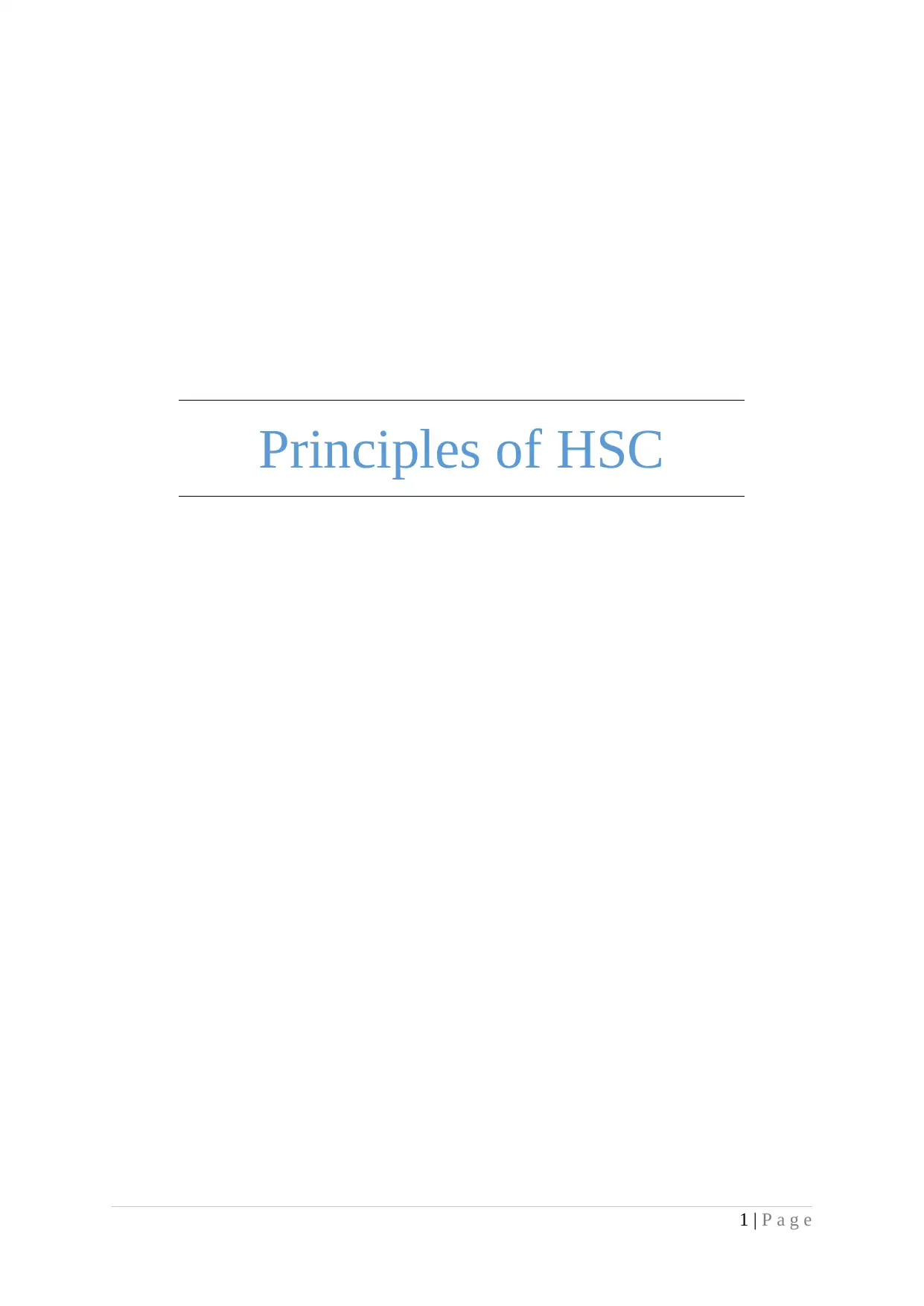
Principles of HSC
1 | P a g e
1 | P a g e
Paraphrase This Document
Need a fresh take? Get an instant paraphrase of this document with our AI Paraphraser
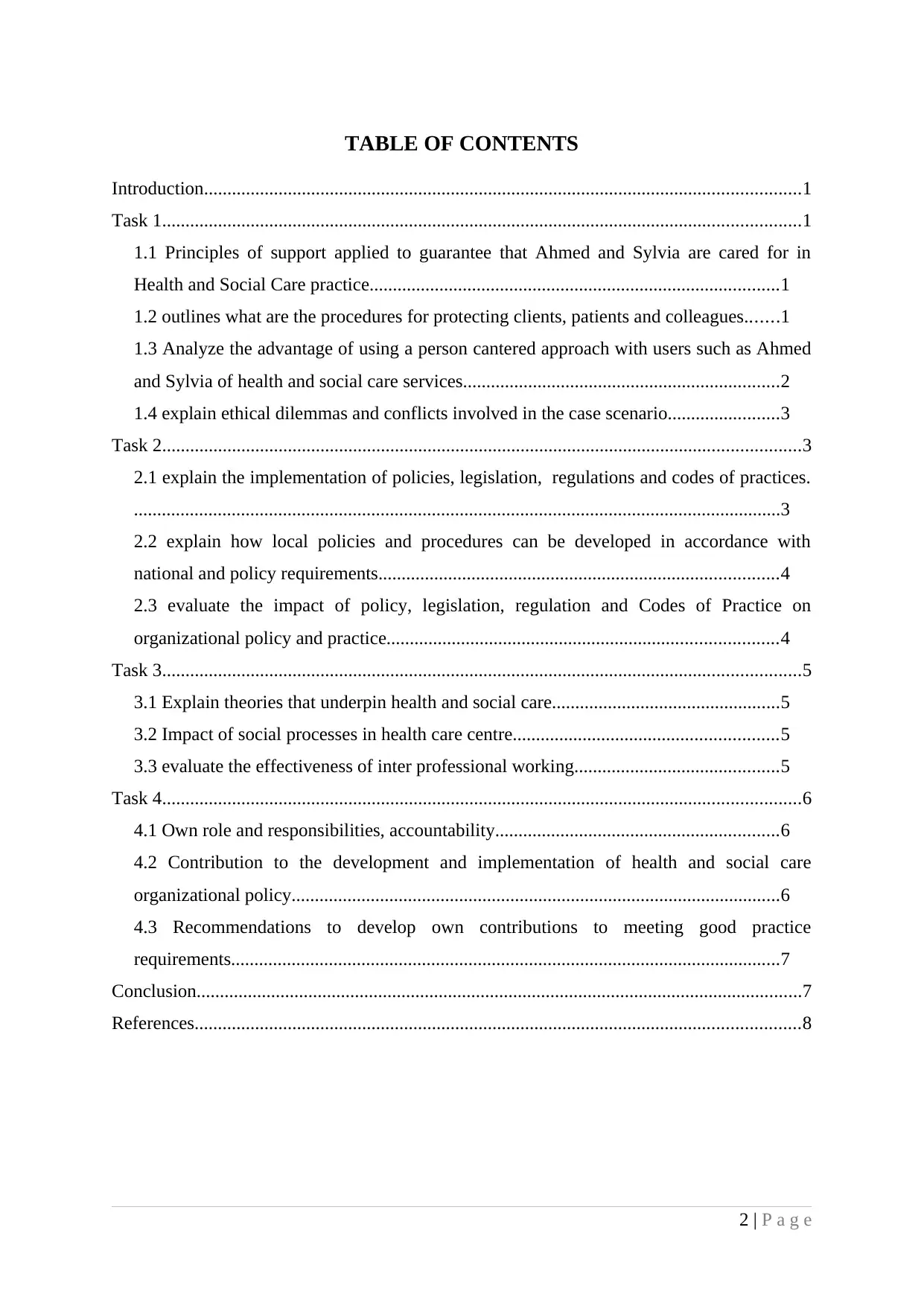
TABLE OF CONTENTS
Introduction................................................................................................................................1
Task 1.........................................................................................................................................1
1.1 Principles of support applied to guarantee that Ahmed and Sylvia are cared for in
Health and Social Care practice........................................................................................1
1.2 outlines what are the procedures for protecting clients, patients and colleagues.......1
1.3 Analyze the advantage of using a person cantered approach with users such as Ahmed
and Sylvia of health and social care services....................................................................2
1.4 explain ethical dilemmas and conflicts involved in the case scenario........................3
Task 2.........................................................................................................................................3
2.1 explain the implementation of policies, legislation, regulations and codes of practices.
...........................................................................................................................................3
2.2 explain how local policies and procedures can be developed in accordance with
national and policy requirements......................................................................................4
2.3 evaluate the impact of policy, legislation, regulation and Codes of Practice on
organizational policy and practice....................................................................................4
Task 3.........................................................................................................................................5
3.1 Explain theories that underpin health and social care.................................................5
3.2 Impact of social processes in health care centre.........................................................5
3.3 evaluate the effectiveness of inter professional working............................................5
Task 4.........................................................................................................................................6
4.1 Own role and responsibilities, accountability.............................................................6
4.2 Contribution to the development and implementation of health and social care
organizational policy.........................................................................................................6
4.3 Recommendations to develop own contributions to meeting good practice
requirements......................................................................................................................7
Conclusion..................................................................................................................................7
References..................................................................................................................................8
2 | P a g e
Introduction................................................................................................................................1
Task 1.........................................................................................................................................1
1.1 Principles of support applied to guarantee that Ahmed and Sylvia are cared for in
Health and Social Care practice........................................................................................1
1.2 outlines what are the procedures for protecting clients, patients and colleagues.......1
1.3 Analyze the advantage of using a person cantered approach with users such as Ahmed
and Sylvia of health and social care services....................................................................2
1.4 explain ethical dilemmas and conflicts involved in the case scenario........................3
Task 2.........................................................................................................................................3
2.1 explain the implementation of policies, legislation, regulations and codes of practices.
...........................................................................................................................................3
2.2 explain how local policies and procedures can be developed in accordance with
national and policy requirements......................................................................................4
2.3 evaluate the impact of policy, legislation, regulation and Codes of Practice on
organizational policy and practice....................................................................................4
Task 3.........................................................................................................................................5
3.1 Explain theories that underpin health and social care.................................................5
3.2 Impact of social processes in health care centre.........................................................5
3.3 evaluate the effectiveness of inter professional working............................................5
Task 4.........................................................................................................................................6
4.1 Own role and responsibilities, accountability.............................................................6
4.2 Contribution to the development and implementation of health and social care
organizational policy.........................................................................................................6
4.3 Recommendations to develop own contributions to meeting good practice
requirements......................................................................................................................7
Conclusion..................................................................................................................................7
References..................................................................................................................................8
2 | P a g e
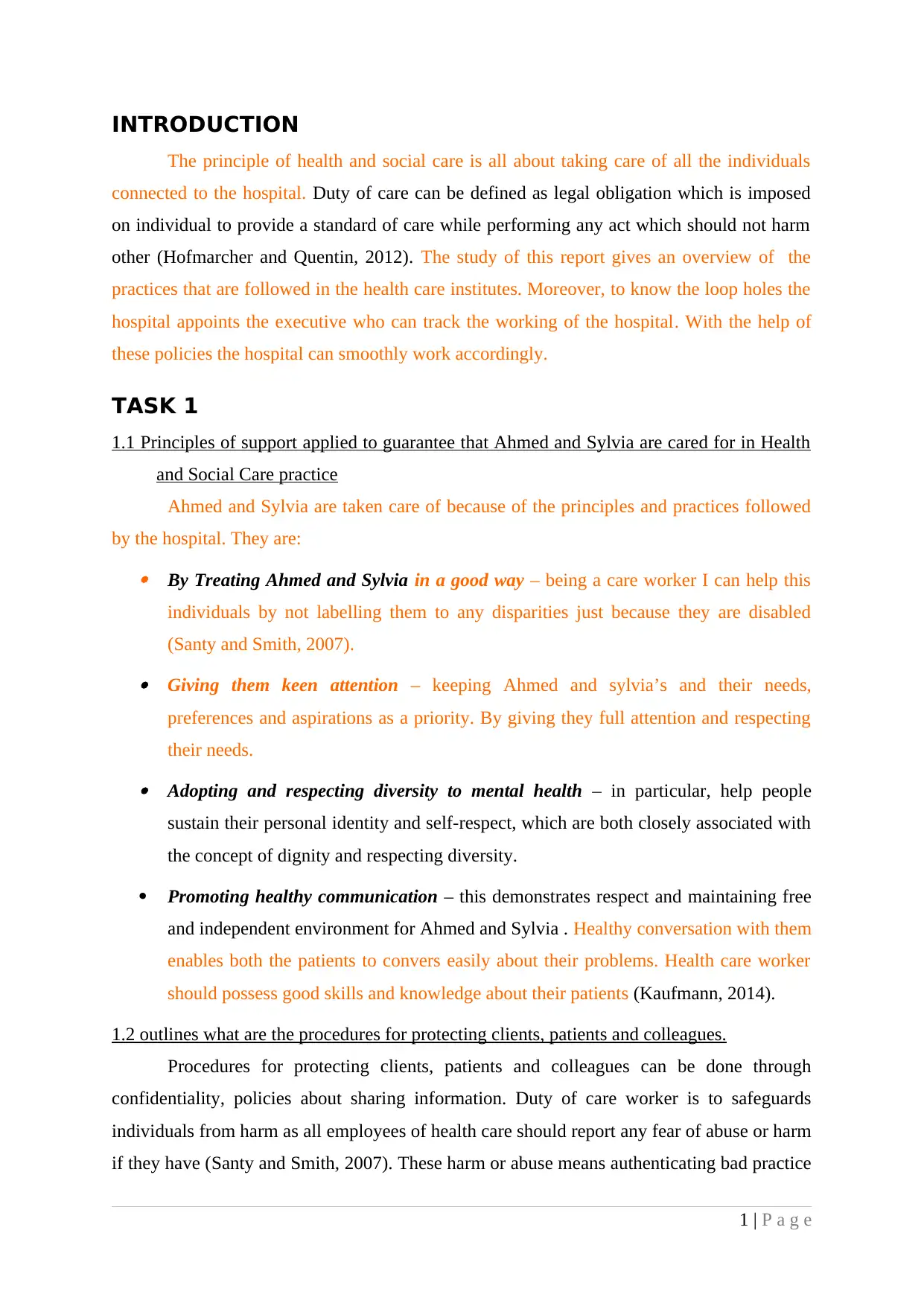
INTRODUCTION
The principle of health and social care is all about taking care of all the individuals
connected to the hospital. Duty of care can be defined as legal obligation which is imposed
on individual to provide a standard of care while performing any act which should not harm
other (Hofmarcher and Quentin, 2012). The study of this report gives an overview of the
practices that are followed in the health care institutes. Moreover, to know the loop holes the
hospital appoints the executive who can track the working of the hospital. With the help of
these policies the hospital can smoothly work accordingly.
TASK 1
1.1 Principles of support applied to guarantee that Ahmed and Sylvia are cared for in Health
and Social Care practice
Ahmed and Sylvia are taken care of because of the principles and practices followed
by the hospital. They are: By Treating Ahmed and Sylvia in a good way – being a care worker I can help this
individuals by not labelling them to any disparities just because they are disabled
(Santy and Smith, 2007). Giving them keen attention – keeping Ahmed and sylvia’s and their needs,
preferences and aspirations as a priority. By giving they full attention and respecting
their needs. Adopting and respecting diversity to mental health – in particular, help people
sustain their personal identity and self-respect, which are both closely associated with
the concept of dignity and respecting diversity.
Promoting healthy communication – this demonstrates respect and maintaining free
and independent environment for Ahmed and Sylvia . Healthy conversation with them
enables both the patients to convers easily about their problems. Health care worker
should possess good skills and knowledge about their patients (Kaufmann, 2014).
1.2 outlines what are the procedures for protecting clients, patients and colleagues.
Procedures for protecting clients, patients and colleagues can be done through
confidentiality, policies about sharing information. Duty of care worker is to safeguards
individuals from harm as all employees of health care should report any fear of abuse or harm
if they have (Santy and Smith, 2007). These harm or abuse means authenticating bad practice
1 | P a g e
The principle of health and social care is all about taking care of all the individuals
connected to the hospital. Duty of care can be defined as legal obligation which is imposed
on individual to provide a standard of care while performing any act which should not harm
other (Hofmarcher and Quentin, 2012). The study of this report gives an overview of the
practices that are followed in the health care institutes. Moreover, to know the loop holes the
hospital appoints the executive who can track the working of the hospital. With the help of
these policies the hospital can smoothly work accordingly.
TASK 1
1.1 Principles of support applied to guarantee that Ahmed and Sylvia are cared for in Health
and Social Care practice
Ahmed and Sylvia are taken care of because of the principles and practices followed
by the hospital. They are: By Treating Ahmed and Sylvia in a good way – being a care worker I can help this
individuals by not labelling them to any disparities just because they are disabled
(Santy and Smith, 2007). Giving them keen attention – keeping Ahmed and sylvia’s and their needs,
preferences and aspirations as a priority. By giving they full attention and respecting
their needs. Adopting and respecting diversity to mental health – in particular, help people
sustain their personal identity and self-respect, which are both closely associated with
the concept of dignity and respecting diversity.
Promoting healthy communication – this demonstrates respect and maintaining free
and independent environment for Ahmed and Sylvia . Healthy conversation with them
enables both the patients to convers easily about their problems. Health care worker
should possess good skills and knowledge about their patients (Kaufmann, 2014).
1.2 outlines what are the procedures for protecting clients, patients and colleagues.
Procedures for protecting clients, patients and colleagues can be done through
confidentiality, policies about sharing information. Duty of care worker is to safeguards
individuals from harm as all employees of health care should report any fear of abuse or harm
if they have (Santy and Smith, 2007). These harm or abuse means authenticating bad practice
1 | P a g e
⊘ This is a preview!⊘
Do you want full access?
Subscribe today to unlock all pages.

Trusted by 1+ million students worldwide
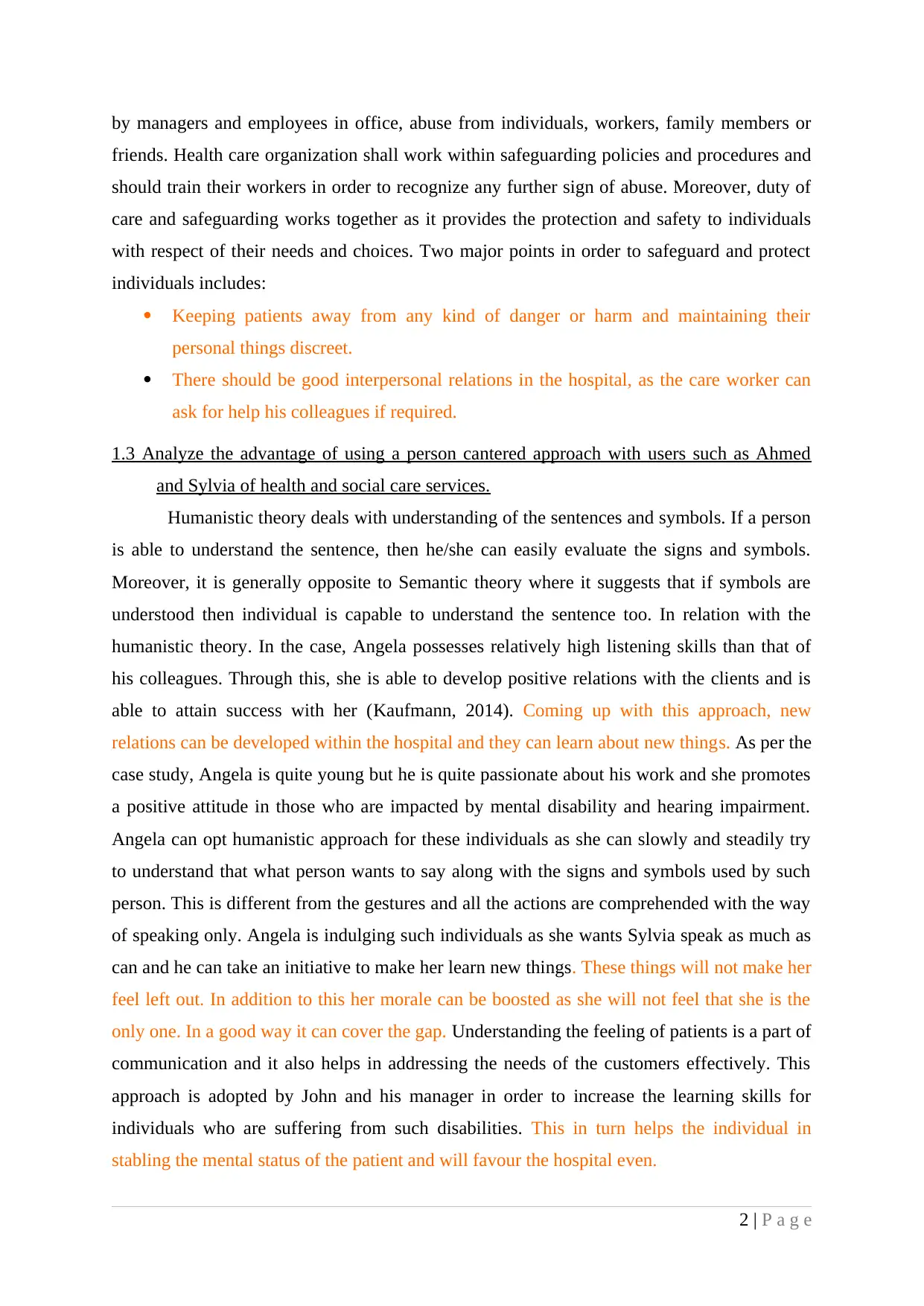
by managers and employees in office, abuse from individuals, workers, family members or
friends. Health care organization shall work within safeguarding policies and procedures and
should train their workers in order to recognize any further sign of abuse. Moreover, duty of
care and safeguarding works together as it provides the protection and safety to individuals
with respect of their needs and choices. Two major points in order to safeguard and protect
individuals includes:
Keeping patients away from any kind of danger or harm and maintaining their
personal things discreet.
There should be good interpersonal relations in the hospital, as the care worker can
ask for help his colleagues if required.
1.3 Analyze the advantage of using a person cantered approach with users such as Ahmed
and Sylvia of health and social care services.
Humanistic theory deals with understanding of the sentences and symbols. If a person
is able to understand the sentence, then he/she can easily evaluate the signs and symbols.
Moreover, it is generally opposite to Semantic theory where it suggests that if symbols are
understood then individual is capable to understand the sentence too. In relation with the
humanistic theory. In the case, Angela possesses relatively high listening skills than that of
his colleagues. Through this, she is able to develop positive relations with the clients and is
able to attain success with her (Kaufmann, 2014). Coming up with this approach, new
relations can be developed within the hospital and they can learn about new things. As per the
case study, Angela is quite young but he is quite passionate about his work and she promotes
a positive attitude in those who are impacted by mental disability and hearing impairment.
Angela can opt humanistic approach for these individuals as she can slowly and steadily try
to understand that what person wants to say along with the signs and symbols used by such
person. This is different from the gestures and all the actions are comprehended with the way
of speaking only. Angela is indulging such individuals as she wants Sylvia speak as much as
can and he can take an initiative to make her learn new things. These things will not make her
feel left out. In addition to this her morale can be boosted as she will not feel that she is the
only one. In a good way it can cover the gap. Understanding the feeling of patients is a part of
communication and it also helps in addressing the needs of the customers effectively. This
approach is adopted by John and his manager in order to increase the learning skills for
individuals who are suffering from such disabilities. This in turn helps the individual in
stabling the mental status of the patient and will favour the hospital even.
2 | P a g e
friends. Health care organization shall work within safeguarding policies and procedures and
should train their workers in order to recognize any further sign of abuse. Moreover, duty of
care and safeguarding works together as it provides the protection and safety to individuals
with respect of their needs and choices. Two major points in order to safeguard and protect
individuals includes:
Keeping patients away from any kind of danger or harm and maintaining their
personal things discreet.
There should be good interpersonal relations in the hospital, as the care worker can
ask for help his colleagues if required.
1.3 Analyze the advantage of using a person cantered approach with users such as Ahmed
and Sylvia of health and social care services.
Humanistic theory deals with understanding of the sentences and symbols. If a person
is able to understand the sentence, then he/she can easily evaluate the signs and symbols.
Moreover, it is generally opposite to Semantic theory where it suggests that if symbols are
understood then individual is capable to understand the sentence too. In relation with the
humanistic theory. In the case, Angela possesses relatively high listening skills than that of
his colleagues. Through this, she is able to develop positive relations with the clients and is
able to attain success with her (Kaufmann, 2014). Coming up with this approach, new
relations can be developed within the hospital and they can learn about new things. As per the
case study, Angela is quite young but he is quite passionate about his work and she promotes
a positive attitude in those who are impacted by mental disability and hearing impairment.
Angela can opt humanistic approach for these individuals as she can slowly and steadily try
to understand that what person wants to say along with the signs and symbols used by such
person. This is different from the gestures and all the actions are comprehended with the way
of speaking only. Angela is indulging such individuals as she wants Sylvia speak as much as
can and he can take an initiative to make her learn new things. These things will not make her
feel left out. In addition to this her morale can be boosted as she will not feel that she is the
only one. In a good way it can cover the gap. Understanding the feeling of patients is a part of
communication and it also helps in addressing the needs of the customers effectively. This
approach is adopted by John and his manager in order to increase the learning skills for
individuals who are suffering from such disabilities. This in turn helps the individual in
stabling the mental status of the patient and will favour the hospital even.
2 | P a g e
Paraphrase This Document
Need a fresh take? Get an instant paraphrase of this document with our AI Paraphraser
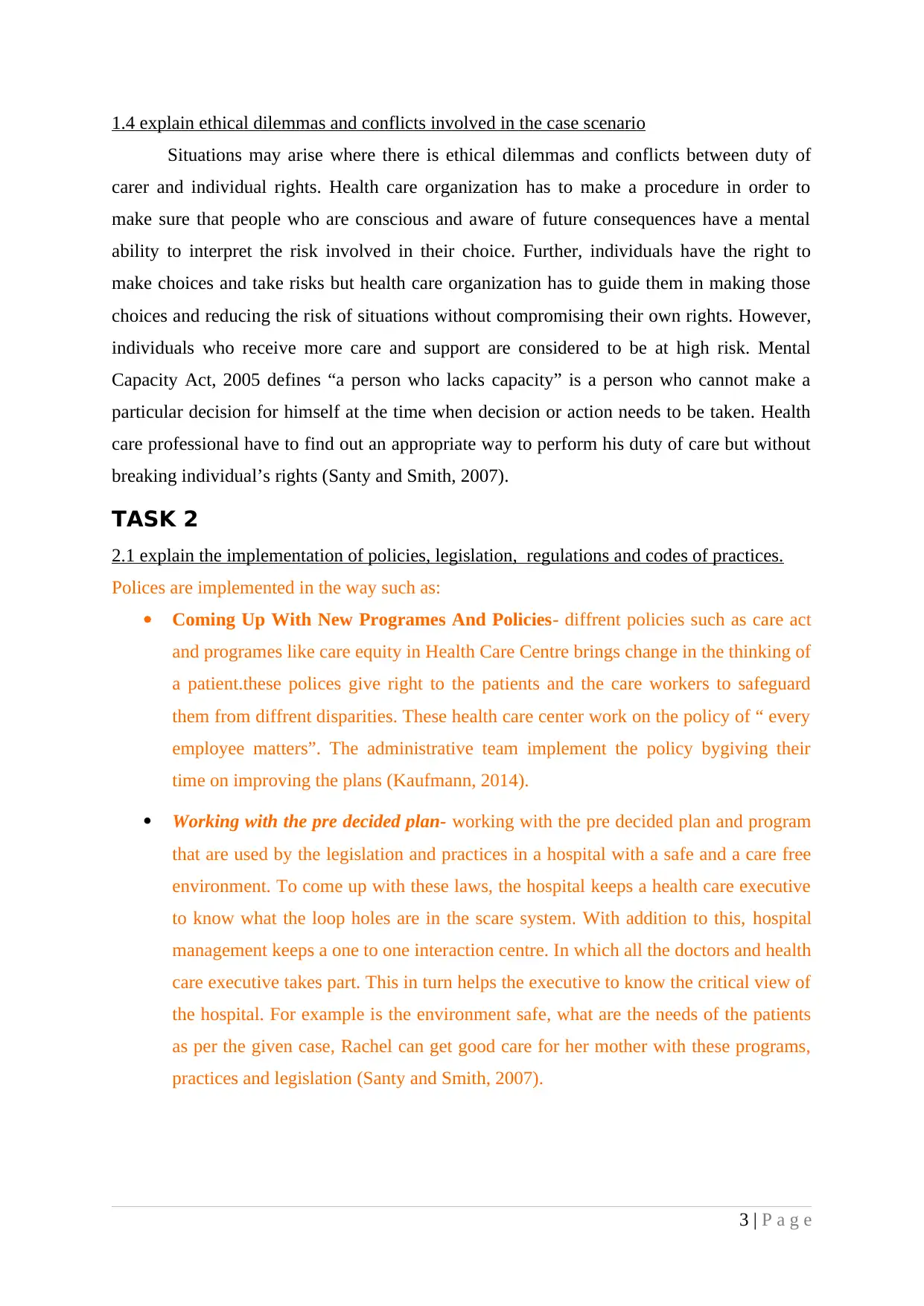
1.4 explain ethical dilemmas and conflicts involved in the case scenario
Situations may arise where there is ethical dilemmas and conflicts between duty of
carer and individual rights. Health care organization has to make a procedure in order to
make sure that people who are conscious and aware of future consequences have a mental
ability to interpret the risk involved in their choice. Further, individuals have the right to
make choices and take risks but health care organization has to guide them in making those
choices and reducing the risk of situations without compromising their own rights. However,
individuals who receive more care and support are considered to be at high risk. Mental
Capacity Act, 2005 defines “a person who lacks capacity” is a person who cannot make a
particular decision for himself at the time when decision or action needs to be taken. Health
care professional have to find out an appropriate way to perform his duty of care but without
breaking individual’s rights (Santy and Smith, 2007).
TASK 2
2.1 explain the implementation of policies, legislation, regulations and codes of practices.
Polices are implemented in the way such as:
Coming Up With New Programes And Policies- diffrent policies such as care act
and programes like care equity in Health Care Centre brings change in the thinking of
a patient.these polices give right to the patients and the care workers to safeguard
them from diffrent disparities. These health care center work on the policy of “ every
employee matters”. The administrative team implement the policy bygiving their
time on improving the plans (Kaufmann, 2014).
Working with the pre decided plan- working with the pre decided plan and program
that are used by the legislation and practices in a hospital with a safe and a care free
environment. To come up with these laws, the hospital keeps a health care executive
to know what the loop holes are in the scare system. With addition to this, hospital
management keeps a one to one interaction centre. In which all the doctors and health
care executive takes part. This in turn helps the executive to know the critical view of
the hospital. For example is the environment safe, what are the needs of the patients
as per the given case, Rachel can get good care for her mother with these programs,
practices and legislation (Santy and Smith, 2007).
3 | P a g e
Situations may arise where there is ethical dilemmas and conflicts between duty of
carer and individual rights. Health care organization has to make a procedure in order to
make sure that people who are conscious and aware of future consequences have a mental
ability to interpret the risk involved in their choice. Further, individuals have the right to
make choices and take risks but health care organization has to guide them in making those
choices and reducing the risk of situations without compromising their own rights. However,
individuals who receive more care and support are considered to be at high risk. Mental
Capacity Act, 2005 defines “a person who lacks capacity” is a person who cannot make a
particular decision for himself at the time when decision or action needs to be taken. Health
care professional have to find out an appropriate way to perform his duty of care but without
breaking individual’s rights (Santy and Smith, 2007).
TASK 2
2.1 explain the implementation of policies, legislation, regulations and codes of practices.
Polices are implemented in the way such as:
Coming Up With New Programes And Policies- diffrent policies such as care act
and programes like care equity in Health Care Centre brings change in the thinking of
a patient.these polices give right to the patients and the care workers to safeguard
them from diffrent disparities. These health care center work on the policy of “ every
employee matters”. The administrative team implement the policy bygiving their
time on improving the plans (Kaufmann, 2014).
Working with the pre decided plan- working with the pre decided plan and program
that are used by the legislation and practices in a hospital with a safe and a care free
environment. To come up with these laws, the hospital keeps a health care executive
to know what the loop holes are in the scare system. With addition to this, hospital
management keeps a one to one interaction centre. In which all the doctors and health
care executive takes part. This in turn helps the executive to know the critical view of
the hospital. For example is the environment safe, what are the needs of the patients
as per the given case, Rachel can get good care for her mother with these programs,
practices and legislation (Santy and Smith, 2007).
3 | P a g e
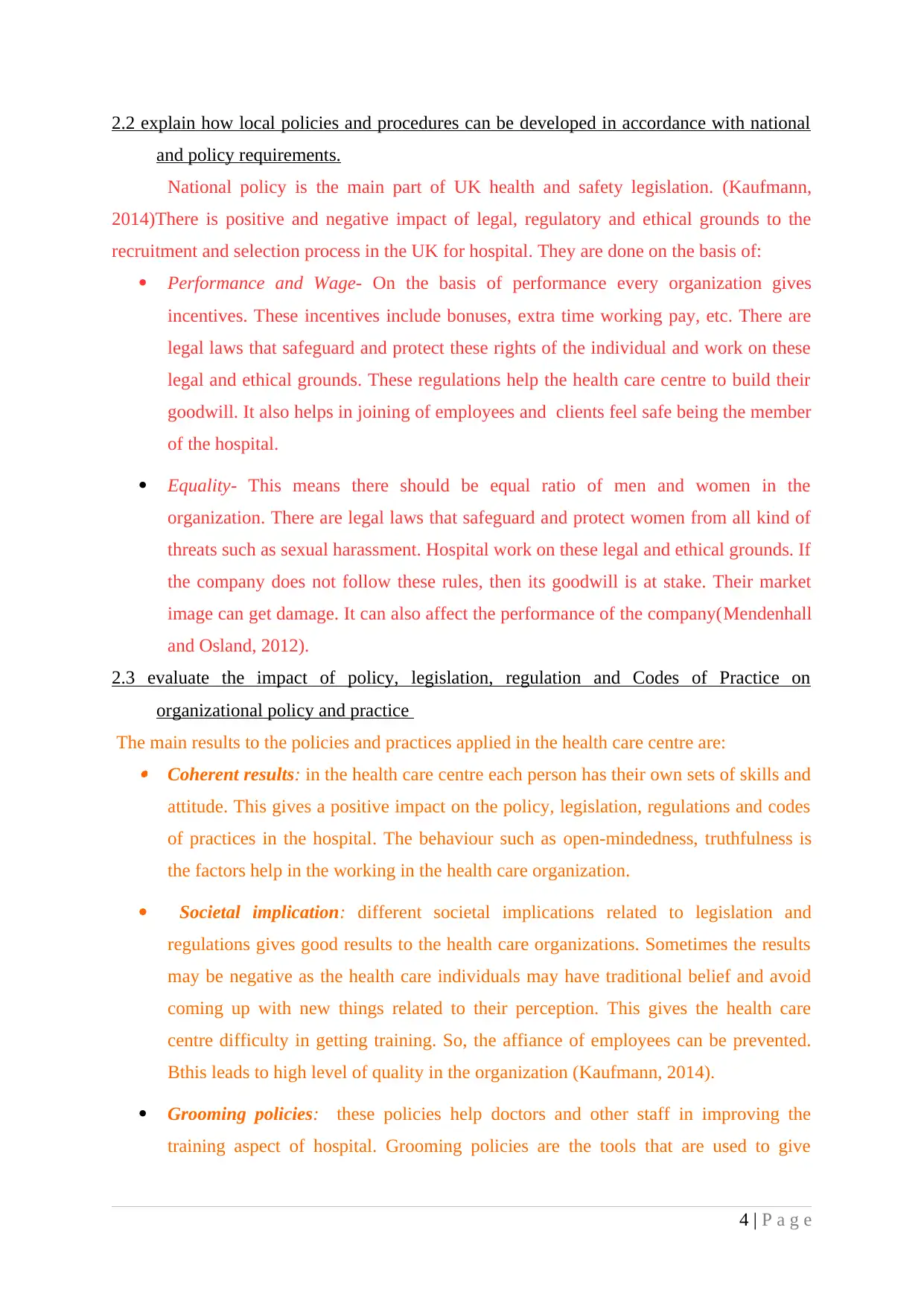
2.2 explain how local policies and procedures can be developed in accordance with national
and policy requirements.
National policy is the main part of UK health and safety legislation. (Kaufmann,
2014)There is positive and negative impact of legal, regulatory and ethical grounds to the
recruitment and selection process in the UK for hospital. They are done on the basis of:
Performance and Wage- On the basis of performance every organization gives
incentives. These incentives include bonuses, extra time working pay, etc. There are
legal laws that safeguard and protect these rights of the individual and work on these
legal and ethical grounds. These regulations help the health care centre to build their
goodwill. It also helps in joining of employees and clients feel safe being the member
of the hospital.
Equality- This means there should be equal ratio of men and women in the
organization. There are legal laws that safeguard and protect women from all kind of
threats such as sexual harassment. Hospital work on these legal and ethical grounds. If
the company does not follow these rules, then its goodwill is at stake. Their market
image can get damage. It can also affect the performance of the company(Mendenhall
and Osland, 2012).
2.3 evaluate the impact of policy, legislation, regulation and Codes of Practice on
organizational policy and practice
The main results to the policies and practices applied in the health care centre are: Coherent results: in the health care centre each person has their own sets of skills and
attitude. This gives a positive impact on the policy, legislation, regulations and codes
of practices in the hospital. The behaviour such as open-mindedness, truthfulness is
the factors help in the working in the health care organization.
Societal implication: different societal implications related to legislation and
regulations gives good results to the health care organizations. Sometimes the results
may be negative as the health care individuals may have traditional belief and avoid
coming up with new things related to their perception. This gives the health care
centre difficulty in getting training. So, the affiance of employees can be prevented.
Bthis leads to high level of quality in the organization (Kaufmann, 2014).
Grooming policies: these policies help doctors and other staff in improving the
training aspect of hospital. Grooming policies are the tools that are used to give
4 | P a g e
and policy requirements.
National policy is the main part of UK health and safety legislation. (Kaufmann,
2014)There is positive and negative impact of legal, regulatory and ethical grounds to the
recruitment and selection process in the UK for hospital. They are done on the basis of:
Performance and Wage- On the basis of performance every organization gives
incentives. These incentives include bonuses, extra time working pay, etc. There are
legal laws that safeguard and protect these rights of the individual and work on these
legal and ethical grounds. These regulations help the health care centre to build their
goodwill. It also helps in joining of employees and clients feel safe being the member
of the hospital.
Equality- This means there should be equal ratio of men and women in the
organization. There are legal laws that safeguard and protect women from all kind of
threats such as sexual harassment. Hospital work on these legal and ethical grounds. If
the company does not follow these rules, then its goodwill is at stake. Their market
image can get damage. It can also affect the performance of the company(Mendenhall
and Osland, 2012).
2.3 evaluate the impact of policy, legislation, regulation and Codes of Practice on
organizational policy and practice
The main results to the policies and practices applied in the health care centre are: Coherent results: in the health care centre each person has their own sets of skills and
attitude. This gives a positive impact on the policy, legislation, regulations and codes
of practices in the hospital. The behaviour such as open-mindedness, truthfulness is
the factors help in the working in the health care organization.
Societal implication: different societal implications related to legislation and
regulations gives good results to the health care organizations. Sometimes the results
may be negative as the health care individuals may have traditional belief and avoid
coming up with new things related to their perception. This gives the health care
centre difficulty in getting training. So, the affiance of employees can be prevented.
Bthis leads to high level of quality in the organization (Kaufmann, 2014).
Grooming policies: these policies help doctors and other staff in improving the
training aspect of hospital. Grooming policies are the tools that are used to give
4 | P a g e
⊘ This is a preview!⊘
Do you want full access?
Subscribe today to unlock all pages.

Trusted by 1+ million students worldwide
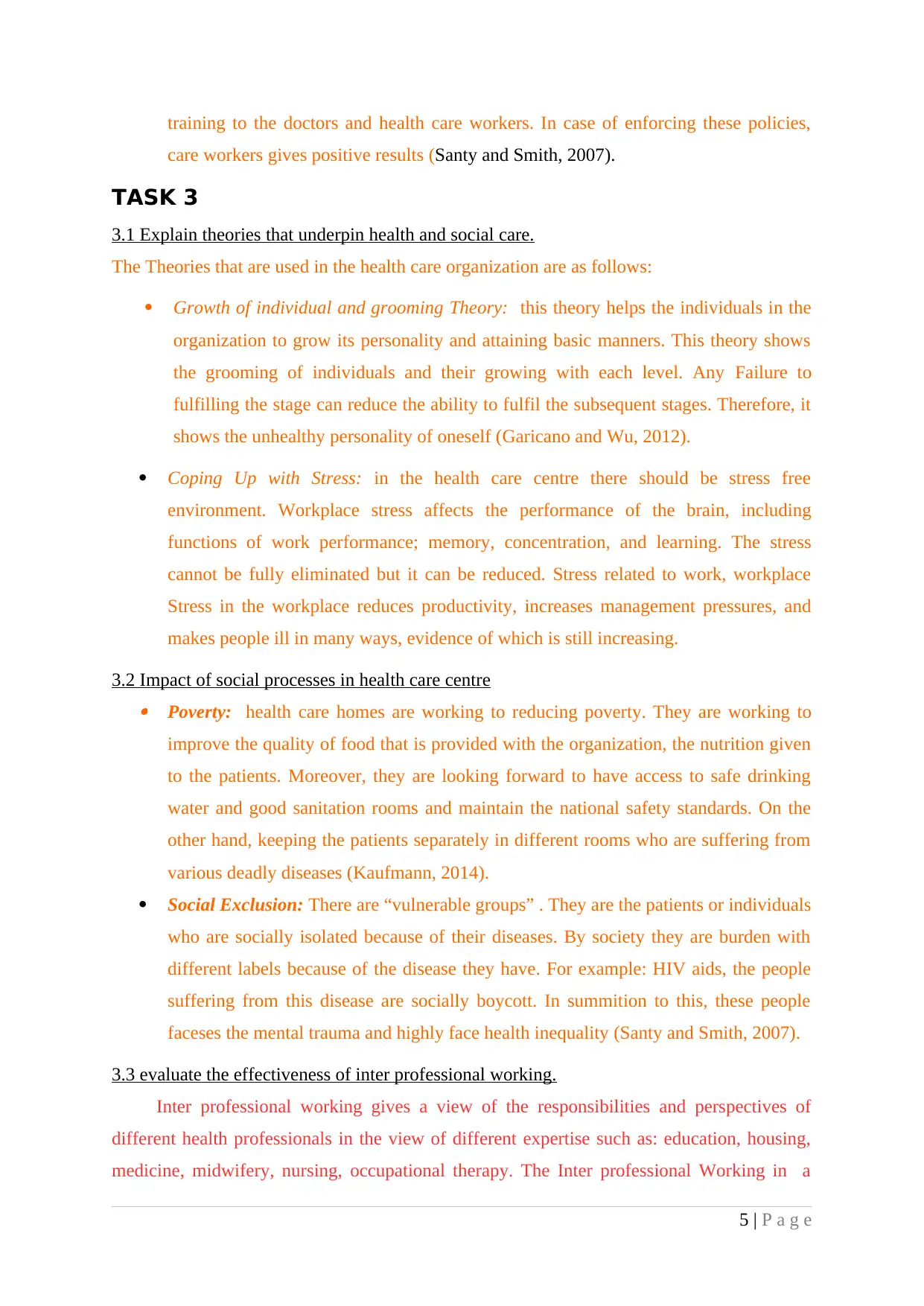
training to the doctors and health care workers. In case of enforcing these policies,
care workers gives positive results (Santy and Smith, 2007).
TASK 3
3.1 Explain theories that underpin health and social care.
The Theories that are used in the health care organization are as follows:
Growth of individual and grooming Theory: this theory helps the individuals in the
organization to grow its personality and attaining basic manners. This theory shows
the grooming of individuals and their growing with each level. Any Failure to
fulfilling the stage can reduce the ability to fulfil the subsequent stages. Therefore, it
shows the unhealthy personality of oneself (Garicano and Wu, 2012).
Coping Up with Stress: in the health care centre there should be stress free
environment. Workplace stress affects the performance of the brain, including
functions of work performance; memory, concentration, and learning. The stress
cannot be fully eliminated but it can be reduced. Stress related to work, workplace
Stress in the workplace reduces productivity, increases management pressures, and
makes people ill in many ways, evidence of which is still increasing.
3.2 Impact of social processes in health care centre Poverty: health care homes are working to reducing poverty. They are working to
improve the quality of food that is provided with the organization, the nutrition given
to the patients. Moreover, they are looking forward to have access to safe drinking
water and good sanitation rooms and maintain the national safety standards. On the
other hand, keeping the patients separately in different rooms who are suffering from
various deadly diseases (Kaufmann, 2014).
Social Exclusion: There are “vulnerable groups” . They are the patients or individuals
who are socially isolated because of their diseases. By society they are burden with
different labels because of the disease they have. For example: HIV aids, the people
suffering from this disease are socially boycott. In summition to this, these people
faceses the mental trauma and highly face health inequality (Santy and Smith, 2007).
3.3 evaluate the effectiveness of inter professional working.
Inter professional working gives a view of the responsibilities and perspectives of
different health professionals in the view of different expertise such as: education, housing,
medicine, midwifery, nursing, occupational therapy. The Inter professional Working in a
5 | P a g e
care workers gives positive results (Santy and Smith, 2007).
TASK 3
3.1 Explain theories that underpin health and social care.
The Theories that are used in the health care organization are as follows:
Growth of individual and grooming Theory: this theory helps the individuals in the
organization to grow its personality and attaining basic manners. This theory shows
the grooming of individuals and their growing with each level. Any Failure to
fulfilling the stage can reduce the ability to fulfil the subsequent stages. Therefore, it
shows the unhealthy personality of oneself (Garicano and Wu, 2012).
Coping Up with Stress: in the health care centre there should be stress free
environment. Workplace stress affects the performance of the brain, including
functions of work performance; memory, concentration, and learning. The stress
cannot be fully eliminated but it can be reduced. Stress related to work, workplace
Stress in the workplace reduces productivity, increases management pressures, and
makes people ill in many ways, evidence of which is still increasing.
3.2 Impact of social processes in health care centre Poverty: health care homes are working to reducing poverty. They are working to
improve the quality of food that is provided with the organization, the nutrition given
to the patients. Moreover, they are looking forward to have access to safe drinking
water and good sanitation rooms and maintain the national safety standards. On the
other hand, keeping the patients separately in different rooms who are suffering from
various deadly diseases (Kaufmann, 2014).
Social Exclusion: There are “vulnerable groups” . They are the patients or individuals
who are socially isolated because of their diseases. By society they are burden with
different labels because of the disease they have. For example: HIV aids, the people
suffering from this disease are socially boycott. In summition to this, these people
faceses the mental trauma and highly face health inequality (Santy and Smith, 2007).
3.3 evaluate the effectiveness of inter professional working.
Inter professional working gives a view of the responsibilities and perspectives of
different health professionals in the view of different expertise such as: education, housing,
medicine, midwifery, nursing, occupational therapy. The Inter professional Working in a
5 | P a g e
Paraphrase This Document
Need a fresh take? Get an instant paraphrase of this document with our AI Paraphraser
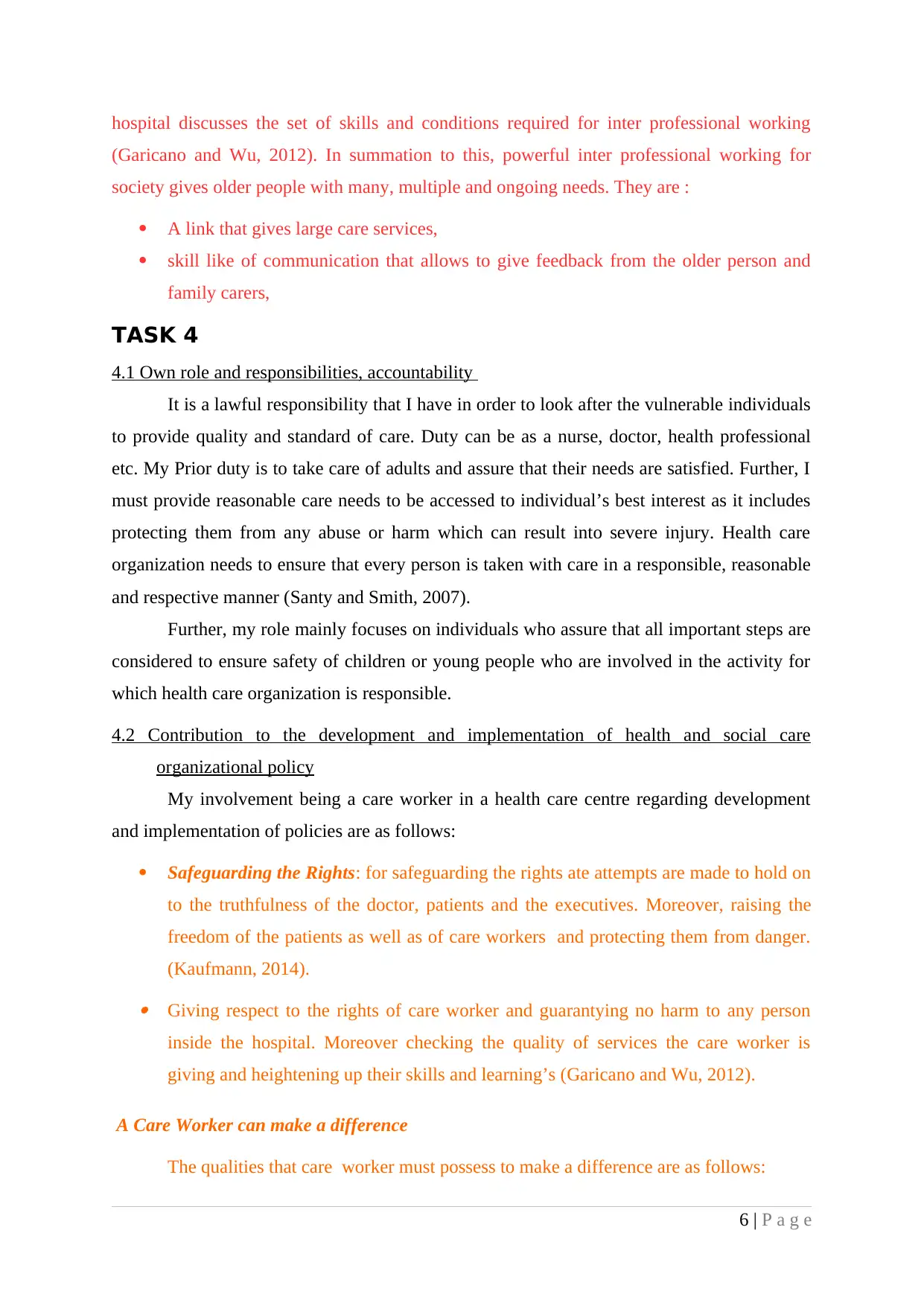
hospital discusses the set of skills and conditions required for inter professional working
(Garicano and Wu, 2012). In summation to this, powerful inter professional working for
society gives older people with many, multiple and ongoing needs. They are :
A link that gives large care services,
skill like of communication that allows to give feedback from the older person and
family carers,
TASK 4
4.1 Own role and responsibilities, accountability
It is a lawful responsibility that I have in order to look after the vulnerable individuals
to provide quality and standard of care. Duty can be as a nurse, doctor, health professional
etc. My Prior duty is to take care of adults and assure that their needs are satisfied. Further, I
must provide reasonable care needs to be accessed to individual’s best interest as it includes
protecting them from any abuse or harm which can result into severe injury. Health care
organization needs to ensure that every person is taken with care in a responsible, reasonable
and respective manner (Santy and Smith, 2007).
Further, my role mainly focuses on individuals who assure that all important steps are
considered to ensure safety of children or young people who are involved in the activity for
which health care organization is responsible.
4.2 Contribution to the development and implementation of health and social care
organizational policy
My involvement being a care worker in a health care centre regarding development
and implementation of policies are as follows:
Safeguarding the Rights: for safeguarding the rights ate attempts are made to hold on
to the truthfulness of the doctor, patients and the executives. Moreover, raising the
freedom of the patients as well as of care workers and protecting them from danger.
(Kaufmann, 2014). Giving respect to the rights of care worker and guarantying no harm to any person
inside the hospital. Moreover checking the quality of services the care worker is
giving and heightening up their skills and learning’s (Garicano and Wu, 2012).
A Care Worker can make a difference
The qualities that care worker must possess to make a difference are as follows:
6 | P a g e
(Garicano and Wu, 2012). In summation to this, powerful inter professional working for
society gives older people with many, multiple and ongoing needs. They are :
A link that gives large care services,
skill like of communication that allows to give feedback from the older person and
family carers,
TASK 4
4.1 Own role and responsibilities, accountability
It is a lawful responsibility that I have in order to look after the vulnerable individuals
to provide quality and standard of care. Duty can be as a nurse, doctor, health professional
etc. My Prior duty is to take care of adults and assure that their needs are satisfied. Further, I
must provide reasonable care needs to be accessed to individual’s best interest as it includes
protecting them from any abuse or harm which can result into severe injury. Health care
organization needs to ensure that every person is taken with care in a responsible, reasonable
and respective manner (Santy and Smith, 2007).
Further, my role mainly focuses on individuals who assure that all important steps are
considered to ensure safety of children or young people who are involved in the activity for
which health care organization is responsible.
4.2 Contribution to the development and implementation of health and social care
organizational policy
My involvement being a care worker in a health care centre regarding development
and implementation of policies are as follows:
Safeguarding the Rights: for safeguarding the rights ate attempts are made to hold on
to the truthfulness of the doctor, patients and the executives. Moreover, raising the
freedom of the patients as well as of care workers and protecting them from danger.
(Kaufmann, 2014). Giving respect to the rights of care worker and guarantying no harm to any person
inside the hospital. Moreover checking the quality of services the care worker is
giving and heightening up their skills and learning’s (Garicano and Wu, 2012).
A Care Worker can make a difference
The qualities that care worker must possess to make a difference are as follows:
6 | P a g e
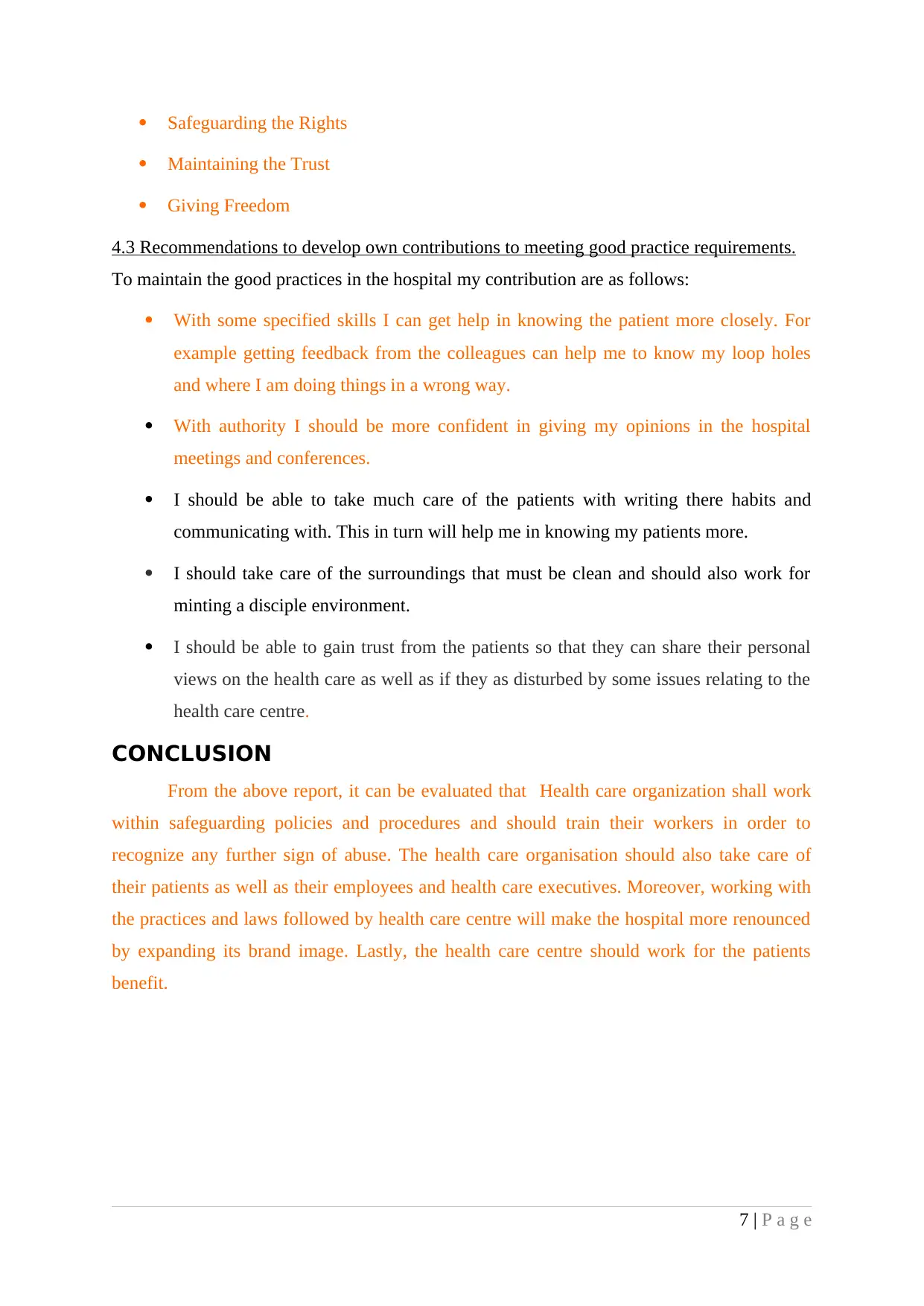
Safeguarding the Rights
Maintaining the Trust
Giving Freedom
4.3 Recommendations to develop own contributions to meeting good practice requirements.
To maintain the good practices in the hospital my contribution are as follows:
With some specified skills I can get help in knowing the patient more closely. For
example getting feedback from the colleagues can help me to know my loop holes
and where I am doing things in a wrong way.
With authority I should be more confident in giving my opinions in the hospital
meetings and conferences.
I should be able to take much care of the patients with writing there habits and
communicating with. This in turn will help me in knowing my patients more.
I should take care of the surroundings that must be clean and should also work for
minting a disciple environment.
I should be able to gain trust from the patients so that they can share their personal
views on the health care as well as if they as disturbed by some issues relating to the
health care centre.
CONCLUSION
From the above report, it can be evaluated that Health care organization shall work
within safeguarding policies and procedures and should train their workers in order to
recognize any further sign of abuse. The health care organisation should also take care of
their patients as well as their employees and health care executives. Moreover, working with
the practices and laws followed by health care centre will make the hospital more renounced
by expanding its brand image. Lastly, the health care centre should work for the patients
benefit.
7 | P a g e
Maintaining the Trust
Giving Freedom
4.3 Recommendations to develop own contributions to meeting good practice requirements.
To maintain the good practices in the hospital my contribution are as follows:
With some specified skills I can get help in knowing the patient more closely. For
example getting feedback from the colleagues can help me to know my loop holes
and where I am doing things in a wrong way.
With authority I should be more confident in giving my opinions in the hospital
meetings and conferences.
I should be able to take much care of the patients with writing there habits and
communicating with. This in turn will help me in knowing my patients more.
I should take care of the surroundings that must be clean and should also work for
minting a disciple environment.
I should be able to gain trust from the patients so that they can share their personal
views on the health care as well as if they as disturbed by some issues relating to the
health care centre.
CONCLUSION
From the above report, it can be evaluated that Health care organization shall work
within safeguarding policies and procedures and should train their workers in order to
recognize any further sign of abuse. The health care organisation should also take care of
their patients as well as their employees and health care executives. Moreover, working with
the practices and laws followed by health care centre will make the hospital more renounced
by expanding its brand image. Lastly, the health care centre should work for the patients
benefit.
7 | P a g e
⊘ This is a preview!⊘
Do you want full access?
Subscribe today to unlock all pages.

Trusted by 1+ million students worldwide
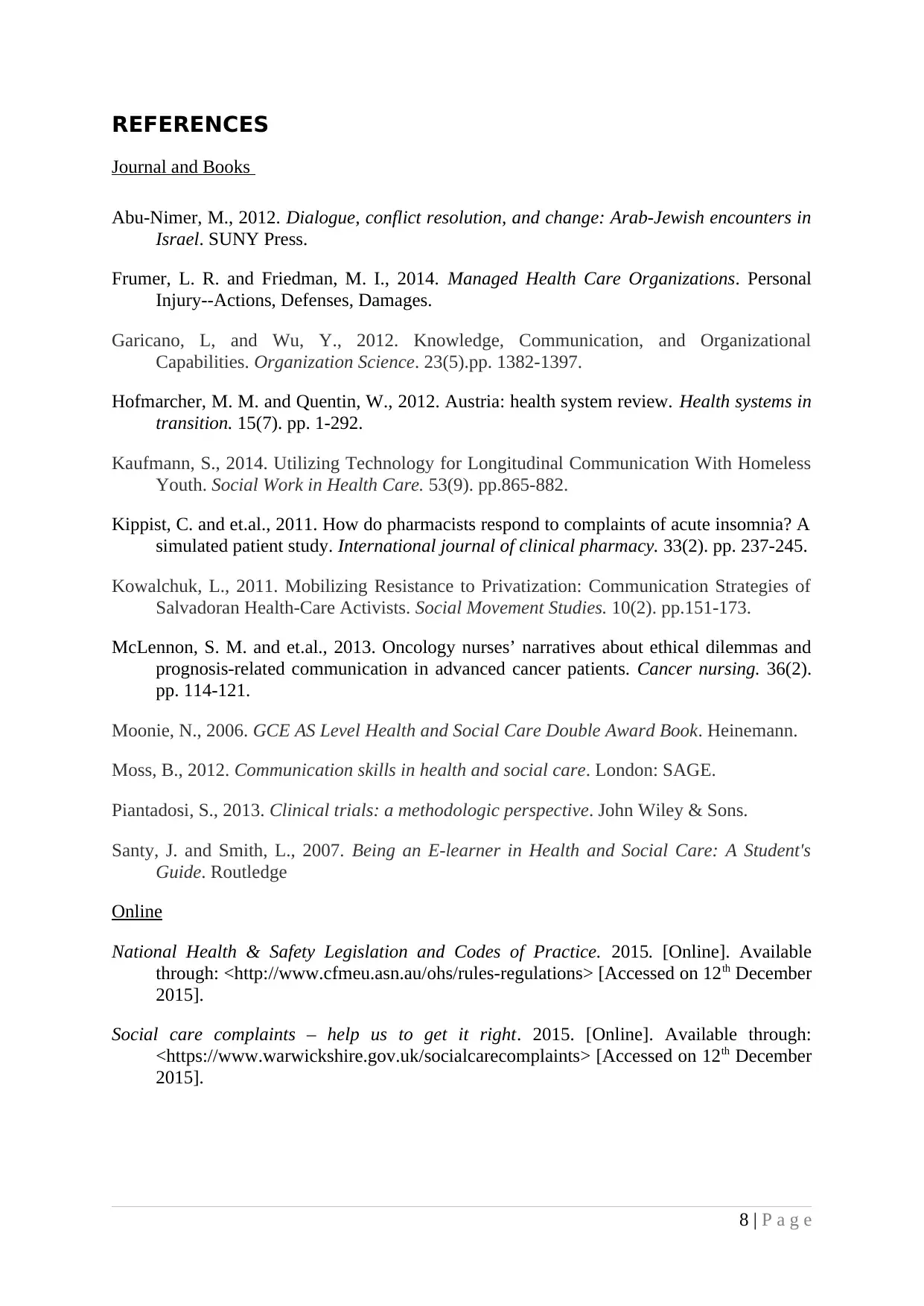
REFERENCES
Journal and Books
Abu-Nimer, M., 2012. Dialogue, conflict resolution, and change: Arab-Jewish encounters in
Israel. SUNY Press.
Frumer, L. R. and Friedman, M. I., 2014. Managed Health Care Organizations. Personal
Injury--Actions, Defenses, Damages.
Garicano, L, and Wu, Y., 2012. Knowledge, Communication, and Organizational
Capabilities. Organization Science. 23(5).pp. 1382-1397.
Hofmarcher, M. M. and Quentin, W., 2012. Austria: health system review. Health systems in
transition. 15(7). pp. 1-292.
Kaufmann, S., 2014. Utilizing Technology for Longitudinal Communication With Homeless
Youth. Social Work in Health Care. 53(9). pp.865-882.
Kippist, C. and et.al., 2011. How do pharmacists respond to complaints of acute insomnia? A
simulated patient study. International journal of clinical pharmacy. 33(2). pp. 237-245.
Kowalchuk, L., 2011. Mobilizing Resistance to Privatization: Communication Strategies of
Salvadoran Health-Care Activists. Social Movement Studies. 10(2). pp.151-173.
McLennon, S. M. and et.al., 2013. Oncology nurses’ narratives about ethical dilemmas and
prognosis-related communication in advanced cancer patients. Cancer nursing. 36(2).
pp. 114-121.
Moonie, N., 2006. GCE AS Level Health and Social Care Double Award Book. Heinemann.
Moss, B., 2012. Communication skills in health and social care. London: SAGE.
Piantadosi, S., 2013. Clinical trials: a methodologic perspective. John Wiley & Sons.
Santy, J. and Smith, L., 2007. Being an E-learner in Health and Social Care: A Student's
Guide. Routledge
Online
National Health & Safety Legislation and Codes of Practice. 2015. [Online]. Available
through: <http://www.cfmeu.asn.au/ohs/rules-regulations> [Accessed on 12th December
2015].
Social care complaints – help us to get it right. 2015. [Online]. Available through:
<https://www.warwickshire.gov.uk/socialcarecomplaints> [Accessed on 12th December
2015].
8 | P a g e
Journal and Books
Abu-Nimer, M., 2012. Dialogue, conflict resolution, and change: Arab-Jewish encounters in
Israel. SUNY Press.
Frumer, L. R. and Friedman, M. I., 2014. Managed Health Care Organizations. Personal
Injury--Actions, Defenses, Damages.
Garicano, L, and Wu, Y., 2012. Knowledge, Communication, and Organizational
Capabilities. Organization Science. 23(5).pp. 1382-1397.
Hofmarcher, M. M. and Quentin, W., 2012. Austria: health system review. Health systems in
transition. 15(7). pp. 1-292.
Kaufmann, S., 2014. Utilizing Technology for Longitudinal Communication With Homeless
Youth. Social Work in Health Care. 53(9). pp.865-882.
Kippist, C. and et.al., 2011. How do pharmacists respond to complaints of acute insomnia? A
simulated patient study. International journal of clinical pharmacy. 33(2). pp. 237-245.
Kowalchuk, L., 2011. Mobilizing Resistance to Privatization: Communication Strategies of
Salvadoran Health-Care Activists. Social Movement Studies. 10(2). pp.151-173.
McLennon, S. M. and et.al., 2013. Oncology nurses’ narratives about ethical dilemmas and
prognosis-related communication in advanced cancer patients. Cancer nursing. 36(2).
pp. 114-121.
Moonie, N., 2006. GCE AS Level Health and Social Care Double Award Book. Heinemann.
Moss, B., 2012. Communication skills in health and social care. London: SAGE.
Piantadosi, S., 2013. Clinical trials: a methodologic perspective. John Wiley & Sons.
Santy, J. and Smith, L., 2007. Being an E-learner in Health and Social Care: A Student's
Guide. Routledge
Online
National Health & Safety Legislation and Codes of Practice. 2015. [Online]. Available
through: <http://www.cfmeu.asn.au/ohs/rules-regulations> [Accessed on 12th December
2015].
Social care complaints – help us to get it right. 2015. [Online]. Available through:
<https://www.warwickshire.gov.uk/socialcarecomplaints> [Accessed on 12th December
2015].
8 | P a g e
1 out of 10
Related Documents
Your All-in-One AI-Powered Toolkit for Academic Success.
+13062052269
info@desklib.com
Available 24*7 on WhatsApp / Email
![[object Object]](/_next/static/media/star-bottom.7253800d.svg)
Unlock your academic potential
Copyright © 2020–2025 A2Z Services. All Rights Reserved. Developed and managed by ZUCOL.





